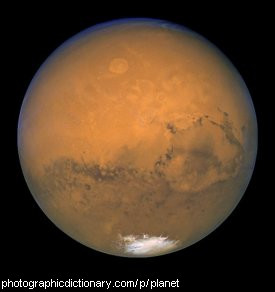An asteroid is very similar to a comet - it is a large rock that orbits the sun. Comets have a tail, while asteroids do not.
Smaller rocks, from the size of a grain of sand to a large bounder are called meteoroids. When they enter the Earth's atmosphere, they are called meteors. If they hit the ground, they are called meteorites. The photo is of a meteorite.
Ais forAtmosphere
In astronomy, an eclipse is where various planetary bodies align and block the light from the sun. In a lunar eclipse, the Earth comes between the sun and the moon. In a solar eclipse, the moon comes between the Earth and the sun. The picture is of a solar eclipse.
In general language, you eclipse someone if you do something so much better or more obviously than they do that everyone notices you and not them, for example "her beauty eclipsed all others at the dance".
A planet is a large body that orbits a sun. Planets, unlike suns, do not give off light. Our solar system has eight planets, nine including pluto. They are:














